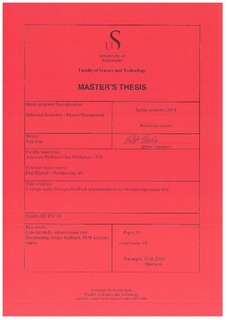| dc.contributor.author | Eide, Erik | |
| dc.date.accessioned | 2014-12-17T13:14:00Z | |
| dc.date.available | 2014-12-17T13:14:00Z | |
| dc.date.issued | 2014-06-12 | |
| dc.identifier.uri | http://hdl.handle.net/11250/227646 | |
| dc.description | Master's thesis in Industrial economics | nb_NO |
| dc.description.abstract | As per now, Oceaneering does not have a 38 000 Nm torque tool with torque feedback for subsea application. As one of Oceaneerings competitors delivers this type of tool with torque feedback within +/- 10 % accuracy, it is essential for Oceaneering to develop a functioning reliable tool with higher accuracy to be able to regain lost market share for these products. The objective of this thesis has been to develop an alternative concept to an already existing concept for torque feedback. Testing of an old 17 000 Nm torque tool with the existing concept revealed high deviation in accuracy (+/- 20 %) which is not acceptable. The condition of the strain gauges in the tool is unknown.
Several concepts were evaluated during concept phase. The concept with the assumed highest accuracy was not chosen as it was estimated to be too expensive to develop and produce. The chosen concept was a new idea and no similar solutions were found during research. Both HBM and Scansense found the concept very exciting and interesting.
Further, FEM analyses of the new concept and the existing concept were performed to determine the accuracy regarding strain distribution in the geometry. Due to the torque tool planetary gear system, the strain distribution changes with the position of the gear. For this reason, the torque feedback concept design has to be minimally affected by this effect. The target accuracy was set to +/- 5 % of read value.
The results from the analyses of the existing concept revealed more accurate results than first anticipated based on the test results from the existing tool with torque feedback. The results showed a deviation of 0.7 % between the gear simulated in position one and position two, and a deviation of 1.7 % between the gear simulated in position two and position three. These results are within accuracy target and it is recommended to perform additional analyses in different positions and to further investigate the condition of the existing tool.
The results from the analyses of the new concept are promising. The same positions as for the existing concept were analyzed and the accuracy was 0.3 % for both positions. The theory the concept is based on adds up with the analyses results, and these results deliver a higher accuracy than the existing concept. Due to the low cost associated with investigating the existing tool and equip it with 8-10 strain gauges to achieve higher accuracy, this is recommended.
Some technical challenges do exist regarding use of strain gauges for subsea application. However, Termo Tight does have experience with use of polypropylene for molding the strain gauges. As long as the strain gauges are exposed to hydrostatic pressure, these issues will be present independently of the concept.
As a result of this thesis, two valid concepts have been investigated and issues regarding strain gauges for subsea use have been revealed. With this work as basis, Oceaneering will have a very good starting point for developing a functioning solution for a torque tool with torque feedback. | nb_NO |
| dc.language.iso | eng | nb_NO |
| dc.publisher | University of Stavanger, Norway | nb_NO |
| dc.relation.ispartofseries | Masteroppgave/UIS-TN-IØRP/2014; | |
| dc.rights | Attribution 3.0 Norway | * |
| dc.rights.uri | http://creativecommons.org/licenses/by/3.0/no/ | * |
| dc.subject | FEM analyses | nb_NO |
| dc.subject | Ansys | nb_NO |
| dc.subject | industriell økonomi | nb_NO |
| dc.subject | concept study | nb_NO |
| dc.subject | subsea torque tool | nb_NO |
| dc.subject | torque feedback | nb_NO |
| dc.title | Concept study of torque feedback implementation for Oceaneering torque tool | nb_NO |
| dc.type | Master thesis | nb_NO |
| dc.subject.nsi | VDP::Social science: 200::Economics: 210 | nb_NO |

